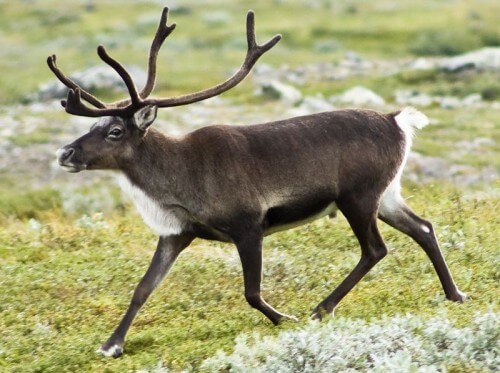The reindeer are able to identify predators and find food against the background of the snow thanks to an extraordinary ability: ultraviolet vision

Ann-Marie Hodge, Scientific American
Ultraviolet radiation (UV) is dangerous for humans: we cannot see it, but it is present in everything and increases our chances of getting skin cancer, cataracts and other diseases. It is mainly harmful in the northern part of the planet, where the depleting ozone layer blocks the ultraviolet rays less and the snow and ice return them to us.
Biologists have therefore wondered how arctic mammals have adapted to the increased UV exposure, an adaptation that allows them not only to withstand the extreme lighting conditions of the poles, but also to derive an evolutionary advantage from them.
A study conducted in northern elk shed some light on the answer to the question. Glen Jeffrey and his colleagues from University College London and the University of Tromsø in Norway presented evidence that this animal, one of the symbols of the Arctic Circle, is not only immune to eye damage due to exposure to strong UV radiation, but is also capable of sensing ultraviolet light.
Reindeer
Only a few mammals, from different families, are endowed with such vision, including several species of rodents, bats and marsupials. The researchers published their findings in the Journal of Experimental Biology.
The ability to see UV gives the reindeer some notable advantages. The moose's main food source in winter, lichens, and the white fur of their main enemies, the wolves, absorb ultraviolet light. Thanks to their unique vision, the most important resources and dangers for reindeer are revealed before their eyes from the snowy landscape.
Evolutionary roots
Ultraviolet vision has deep roots in the mammalian genealogy: early mammals that lived tens of millions of years ago had a short-wavelength sensitive visual receptor, SWS1.
Sensitivity was probably shifted to longer wavelengths in visible light, away from short-wavelength UV radiation, because most mammals back then were nocturnal and ultraviolet vision is useless at night.
The fact that UV vision was shared by all ancient mammals could explain how a small but diverse group of animals reacquired the trait.
learn from the elk
If the scientists succeed in finding out how the reindeer's eyes are protected from the harmful effects of ultraviolet radiation, it is possible that new ways will be found to treat vision loss in humans. The average person loses 20% to 30% of their central photoreceptors during their lifetime. Most of the damage is due to exposure to light.
"We may learn how to better treat the loss of retinal cells that accompanies puberty, and perhaps also macular degeneration associated with aging," says Jeffrey.
Meanwhile, the discovery that the reindeer see ultraviolet light and are also immune to the damage of this strong radiation sheds new light on the question of the Arctic animals' adaptation to one of the most extreme habitats in the world.

6 תגובות
Yotam Yosef - just as your eyes see electromagnetic radiation in visible light (400-700), and when the more radiation an object absorbs, the darker it appears, and the more radiation it emits, the brighter it appears, so do wolves' fur. If their fur absorbs ultraviolet radiation, in the eyes of the moose their fur will look duller and stand out relative to the environment that does not absorb such radiation and even deflects such radiation as in the case of the snow.
Eran, humans are also able to see ultraviolet radiation. The lens blocks the radiation, so most of us don't notice it. People with a damaged lens, or one that has been replaced with an artificial lens that does not absorb UV radiation, see this wavelength but pay a price in damage to the retina. Most birds also notice UV.
The interesting part is not the ability to distinguish UV radiation, but "how the reindeer's eyes are protected from the harmful effects of ultraviolet radiation". That is, how some animals deal with the damage to the eye that such radiation can do
Isn't it more likely that most mammals simply lost the above vision and only a small group preserved (and did not lose and adapt again)?
Thanks for the attention. I uploaded a correct picture to the server but accidentally pulled the wrong one into the article. Now it's fixed.
Come on, the picture is neither Eyal nor North, do yourself a favor and replace it, it's embarrassing, it's not even the picture on Wikipedia
Very important information is missing. Why does ultraviolet vision help identify predators? Light is light. Does the snow absorb some of the ultraviolet light? Are the carnivores and lichens?